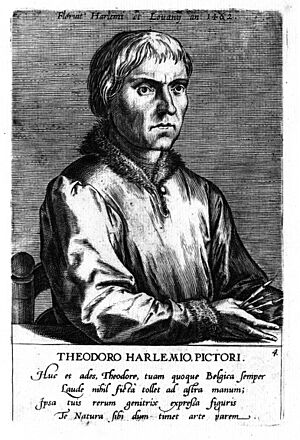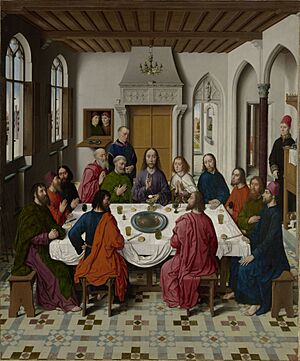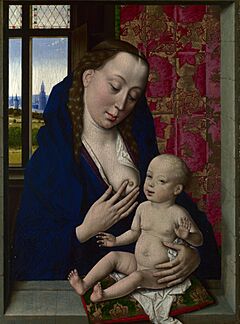Dieric Bouts facts for kids
Quick facts for kids
Dieric Bouts
|
|
|---|---|

Portrait engraving of Bouts
|
|
| Born | c. 1415 |
| Died | 6 May 1475 |
| Nationality | Flemish |
| Education | Rogier van der Weyden (possibly) |
| Known for | painting |
| Movement | Early Netherlandish painting, Northern Renaissance |
Dieric Bouts (born around 1415 – died May 6, 1475) was an important painter from the Netherlands. He was one of the first artists in northern Europe to use a special drawing technique called linear perspective. This technique makes paintings look like they have real depth.
Bouts might have learned from another famous painter, Rogier van der Weyden. His art was definitely shaped by van der Weyden and Jan van Eyck. Bouts lived and worked in Leuven, a city in Belgium, from about 1457 until he passed away in 1475.
Contents
Dieric Bouts' Famous Paintings
Dieric Bouts created many different types of paintings. Some of his most important works include large altarpieces and smaller pictures for people to use in their prayers. He also painted portraits of people.
Early Artworks (Before 1464)
One of Bouts' earliest known paintings is the Triptych of the Virgin's Life. This painting, made around 1445, is now in the Prado Museum in Madrid, Spain. Another early work, the Deposition Altarpiece, was likely painted around 1450–1460.
The Last Supper Painting
One of Bouts' most famous paintings is The Last Supper. It's the main part of a larger artwork called the Altarpiece of the Holy Sacrament. The church in Leuven asked Bouts to paint this in 1464.
In The Last Supper, Bouts showed off his skill with linear perspective. He made all the lines in the main room meet at one single point above Christ's head. This makes the painting look very realistic and deep. It was one of the first paintings in the Netherlands to show such a good understanding of this technique.
Bouts' Last Supper was also special because it was the first time this scene was painted on a wooden panel in the Flemish style. Instead of focusing on Judas's betrayal, Bouts showed Christ performing the consecration of the Eucharistic host. This is a key part of the Catholic Mass. Bouts also included four servants in the painting, dressed in regular Flemish clothes. These servants are probably portraits of the church members who asked him to paint the altarpiece.
The Altarpiece of the Holy Sacrament also had four other panels. These panels showed scenes from the Bible that were connected to the Last Supper. For example, one panel showed Abraham and Melchizedek, and another showed the Gathering of the Manna. These scenes were meant to help people understand the meaning of the Last Supper.
Paintings for the City of Leuven
After becoming the official city painter of Leuven in 1468, Bouts received two big jobs for the Town Hall. The first was an altarpiece about the Last Judgment (1468–1470). Today, only two parts of this painting remain: The Road to Paradise and The Fall of the Damned.
After that, he started working on the larger Justice Panels (1470–1475). These paintings told stories about the life of an old emperor named Otto III. Bouts finished one panel and started a second before he died in 1475. These paintings are now in the Royal Museums of Fine Arts of Belgium in Brussels. The other two panels were never finished.
Small Paintings and Portraits
Many of Bouts' true works are small paintings made for prayer. These often show the Virgin Mary and baby Jesus. An early example is the Davis Madonna in New York. The Virgin and Child in the National Gallery, London is one of his biggest and most detailed paintings of Mary.

Bouts also painted many portraits. He built on the style of other famous painters like Jan van Eyck. His 1462 Portrait of a Man is special because it was one of the first portraits to show the person from a slight angle, with a clear background that even includes a view of the landscape outside a window.
Other Artworks by Bouts
Besides The Last Supper and the Justice Panels, other paintings are also believed to be by Bouts. These include the remaining parts of the Last Judgment Altarpiece and the triptych The Martyrdom of St Erasmus.
Many other paintings are also linked to him. These include Christ in the House of Simon and a Nativity fragment. You can find his works in museums all over the world, like the Louvre in Paris and the National Gallery, London.
Bouts' Family Life
Dieric Bouts was married twice and had four children. His two daughters became nuns. His two sons, Dieric the Younger and Aelbrecht, also became painters. They continued their father's artistic style into the 16th century. Dieric the Younger followed his father's style closely. Aelbrecht developed his own unique style, which helped keep Bouts' artistic ideas alive for many years.
Exhibition: Dieric Bouts, Creator of Images
In 2023, a special art show called Dieric Bouts, Creator of Images was held in Leuven, Belgium. This exhibition showed many of Bouts' works. It focused on how he painted religious scenes, landscapes, and how he used perspective. The exhibition also explored how Bouts' art connects to the visual world we see today.
Images for kids
See also
 In Spanish: Dirk Bouts para niños
In Spanish: Dirk Bouts para niños




